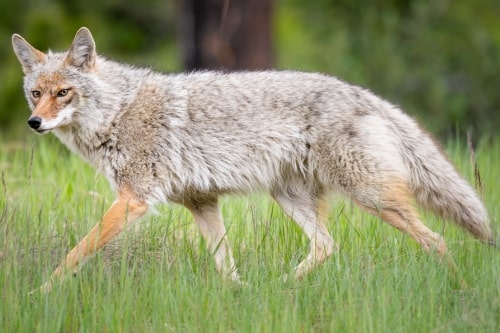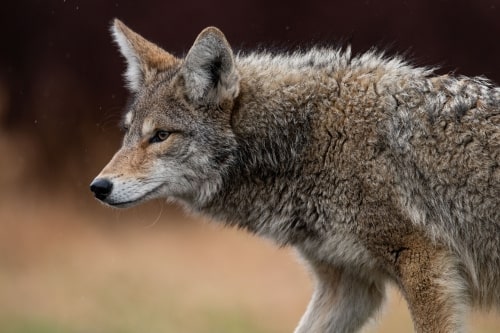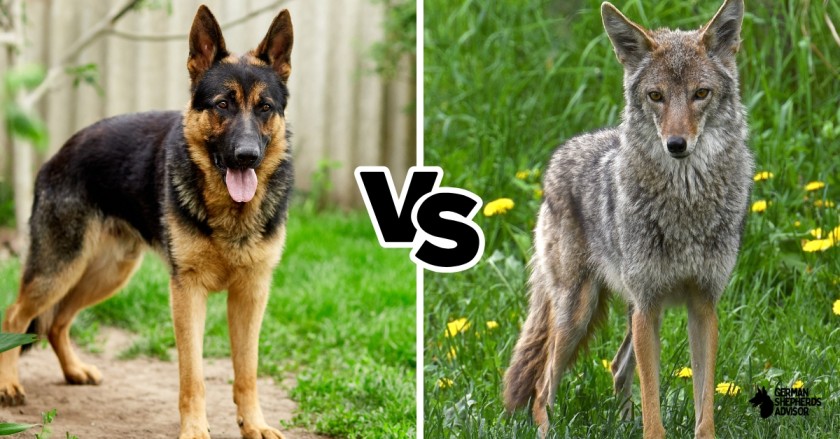The German shepherd is a large, muscular dog that was originally bred for herding sheep. Coyotes are smaller, leaner animals that were typically used to hunt small prey such as rabbits and rodents.
While the German shepherd is an excellent guard dog, capable of deterring would-be intruders, the coyote is known for its cunning and resourcefulness. A coyote will often outwit potential predators by using its quick reflexes and sharp intelligence.
In general, the German shepherd is considered to be a more aggressive breed than the coyote. A well-trained German shepherd will protect its family and property with determination, while a coyote will generally only attack if it feels threatened or cornered.
So which of these animals is more aggressive? …
A German shepherd will attack when it feels that its family or property is being threatened, while a coyote may also attack under similar circumstances. However, the coyote is more likely to flee if it feels threatened, while the German shepherd may continue to attack. Ultimately, it is up to the individual dog’s temperament and training how aggressive it will be. So, while a German shepherd can be an excellent guard dog, a coyote is also a very capable animal that should not be underestimated. Both of these breeds have their own unique strengths and weaknesses, so it is important to do your research before deciding which one is right for you. Coyotes are known for their aggressive behavior in urban areas.
This is interesting because they are not typically thought of as having an aggressive temperament, unlike dogs or wolves. The coyote is typically viewed as a shy and elusive animal that does not want any trouble. Though it may be rare, there have been documented cases of coyotes attacking humans when cornered or when protecting things like food. Coyotes typically only attack if threatened or provoked; this also includes hunting small prey such as mice or rabbits (Fisher et al 2009). People should take these behaviors into account when dealing with wild animals like coyotes since they can sometimes pose a threat to humans (Mahmud 2010). Coyote attacks are usually unprovoked and can result in serious injuries, so caution is always advised when encountering these animals.
Appearance
Most of what we know today about coyote behavior comes from the work of researchers in the field, who have spent their lives observing social life in wild coyotes. Few people realize that only 10 percent of the original habitat of North America has been lost over the past 200 years. Coyotes were originally found throughout most of this continent, but by the 1950s they had retreated to remote areas and were considered no more than a nuisance. Years ago they were often killed because they preyed on livestock; now that their habitats are gone or fragmented, these animals find themselves in conflict with humans once again.
No one knows exactly how many coyotes live in North America today, but some estimate there may be as many as 500,000. Coyotes are adaptable and can live in a variety of habitats, including deserts, grasslands, forests, and even suburban neighborhoods. They are typically about the size of a small German shepherd, but their ears and tail are much longer. The coloration of their fur varies with the season: in the winter they are gray or brownish-gray, while in the summer they are buff-yellow or light gray.
Coyotes mainly eat small mammals such as rabbits, rodents, and groundhogs, but they will also eat insects, fruits, and vegetables. They usually hunt alone or in pairs but may also form packs when hunting larger prey. They are very agile and can run up to 40 per hour. Coyotes communicate with each other through a variety of vocalizations, including barks, howls, and yips. They also use body language to communicate, such as raising their hackles (the hair on their back) when they are angry or frightened.
Coyotes play an important role in the ecosystems where they live. For example, they help control the population size of prey animals and can help keep gardens free of pests. Some people believe that coyotes can also help reduce crime rates in urban areas by deterring other predators such as raccoons and skunks. Despite their reputation as nuisances, coyotes are fascinating animals that deserve our respect. There is no definitive answer to this question, as it depends on a number of factors including the size and age of the animals involved, as well as the terrain and weather conditions. However, in general, coyotes are smaller and faster than German Shepherds, and they are also better adapted to living in harsh environments. As a result, they would probably be more successful in outrunning or outmaneuvering a German Shepherd.
On the other hand, German Shepherds are much larger and stronger than coyotes, and they are also considered to be more aggressive. They may have a better chance of overpowering a coyote in a physical confrontation. Additionally, German Shepherds are known for their intelligence and loyalty, which would give them an advantage in most confrontations with wild animals.
In this particular case, the coyote appears to have used its more effective strategy for dealing with larger predators (outrunning the German Shepherd) and was successful. However, there are many instances where a large dog (such as a German Shepherd) has killed a coyote, even though it may not necessarily win every encounter. More importantly, humans should never encourage their dogs to engage in contests like this one. Not only does it usually end badly for both animal participants along with that it leaves a bad taste.
Can a dog beat a coyote

There are a few things to consider when asking this question. For one, coyotes are much smaller than dogs, so a dog would have an advantage in size. In addition, coyotes are more agile and can run faster than dogs. However, dogs are typically more aggressive and have stronger jaws, so they could potentially beat a coyote in a fight. It really depends on the individual dog and coyote involved in the altercation. Ultimately, it is difficult to say for sure who would win in a battle between these two animals.
Some people believe that dogs can definitely beat coyotes, while others believe that coyotes have the advantage. There is no definitive answer either way. Each animal has its own unique set of strengths and weaknesses. When in an altercation, it really depends on the individual dog and coyote involved. A formal assessment of whether or not dogs are capable of beating coyotes must take into account many different factors, including the species, breed, size, age, health conditions (including starvation), fighting experience, and motivation to fight of each animal. Furthermore, even if there were no other animals involved in the conflict besides a domestic dog and a coyote, one could make compelling cases for either side winning based on simple observation of their interactions with humans. Coyotes have successfully attacked small children by grabbing them around the head area while running at full speed which would suggest that they could potentially beat some dogs. On the other hand observations of pet dogs fighting with coyotes have resulted in the dog being successful in driving away the coyote.
It is important to remember that the scenario described above would likely be very different from an actual fight between a dog and a coyote in the wild. In fact, it is highly unlikely that a domestic dog would ever encounter a coyote in the wild unless the coyote was preying on the dog’s owner’s livestock. Coyotes are becoming increasingly comfortable around humans and are less likely to run away when encountering people or pets. Domestic dogs, however, have not evolved to deal with this kind of interaction and may become agitated, which could lead to them being injured or killed by a coyote.
Short haired coyote
The short-haired coyote is one of the most common coyote variants in North America. It has shorter fur than other coyote variants and is typically light brown or gray in color. This variant is well-adapted to living in cold climates, and is found throughout the northern United States and southern Canada. Despite its name, the short haired coyote is not always shorter-haired than other coyote variants. Some individuals have longer fur, while others have very short fur. The coat color can also vary significantly, ranging from light brown to black. The short haired coyote is a very versatile predator that feeds on a wide variety of prey items. It hunts small mammals, such as rabbits and rodents, and sometimes hunts larger prey items such as deer and livestock. It occasionally scavenges human garbage and road kill for food.
Breeding can occur throughout the year in short haired coyotes. Pregnancies typically last around 9 weeks, with an average of 4 to 5 pups born per litter. The young are raised in dens not far from where they were born and stay with their parents for about a year after birth before dispersing to find territories of their own. This variant is one of the most abundant types of coyote in North America, but its numbers appear to be declining slightly due to predator control programs and increased hunting pressure. The only known significant threat against the short haired coyote is human-related mortality, but as with all coyote variants, it is not currently considered endangered.
Coyote bite force

For many decades, research on the evolution of canine morphology has been greatly influenced by Payne (1987) , who suggested that canines evolved a bone-crushing specialization to enable them to exploit a new dietary resource: vertebrate prey. Subsequent studies have largely supported this view, yet evidence for craniodental adaptation among living carnivorans is surprisingly limited. Furthermore, many extant species are characterized by masticatory structures that would seem ill-suited for crushing hard prey items. The relatively weak functional demands imposed by the diets of some felids and ursids suggest they may offer an informative contrast to other members of their respective families in terms of craniodental adaptations for predation. Here we test predictions about the relationship between functional feeding ecology and craniodental morphology in living carnivorans by quantifying bite force (BF) in eight mammalian species representing five families: Ursidae (black bear), Felidae (lion), Canidae (gray wolf, coyote), Procyonidae (raccoon), and Mustelidae (wolverine, marten, fisher).
We used a custom-built bite force apparatus to measure the maximum BF of each species. Maximum BF was measured for both male and female individuals across a range of body masses. We found that the relationship between BF and body mass is not phylogenetically conserved. In fact, the relationship between BF and body mass varies markedly among different carnivoran families. Maximum BF ranged from 927 N in the fisher to 4,862 N in the black bear. However, we found no evidence that species with craniodental specializations for crushing (carnassial teeth and sagittal crest) had higher BF than species without such specializations; there was no relationship between either of these variables and maximum BF within our sample.
Roughly half of the variance in our regression model is explained by phylogeny and body mass. This may suggest that evolutionary changes in craniodental morphology have been driven by shifts toward larger body size across carnivoran families. We conclude that variation among extant carnivorans in craniodental adaptations for predation is not well explained by estimates of BF alone, but future studies should test alternative explanations for this pattern, such as intracranial constraints on jaw muscle size and leverage. The results of our study suggest that the relationship between BF and diet is more complex than has been previously assumed, and that variation in craniodental morphology within and among carnivoran families is likely related to a variety of factors, including body size and hunting strategies. Additional research on the interaction between craniodental morphology and feeding ecology in living carnivorans is urgently needed if we are to understand the evolution of this important functional trait.
Interestingly, our study found that the black bear had the strongest bite force of all the species studied. This may be due, in part, to the fact that they are generalist predators with a varied diet that includes both vertebrate and invertebrate prey. The coyote, on the other hand, had the weakest bite force of all the species studied. This may be due to their diet, which is largely composed of small mammals, birds, and insects.
In conclusion, our study provides new insights into the relationship between craniodental morphology and feeding ecology in living carnivorans. It underscores the importance of taking a multivariate approach when investigating this topic and suggests that further research on this subject is urgently needed. Coyotes are known to have a weaker bite force than most other canid predators. Their relatively weak jaw muscles and lack of robust cranial features suggest that they are not well-suited for crushing hard prey items.
Comparison
Both the German shepherd and the coyote are members of the canine family, but they are very different animals. The German shepherd is a large dog, standing about 24 inches at the shoulder and weighing anywhere from 55 to 85 pounds. The coyote, on the other hand, is much smaller, typically measuring only 18 to 26 inches in height and weighing between 20 and 40 pounds.
The German shepherd is a popular pet because of its friendly personality and loving nature. However, it is also an excellent working dog, used for tasks such as search and rescue, tracking, police work, and guarding property. The coyote is not typically kept as a pet, but rather is considered a wild animal. Coyotes are well known for their intelligence, adaptability, and resourcefulness.
Physical Characteristics
The coyote is known for its distinctive coloring, which features a grayish-brown coat with reddish tinges on the ears, back, and tail. It has a bushy black-tipped tail that measures about 13 inches in length. Coyotes also have long faces and pointed snouts that resemble those of domestic dogs such as Collies or Beagles. Although the German shepherd is similar in appearance to some breeds of domestic dog (such as Border collies), it was originally bred from stock found in central Asia such as the Russian sheepdog and the Sarplaninac. Its coat color typically ranges from tan to black with dark shadings on the muzzle and forehead, while its tail is long and bushy.
Mating Habits Coyotes breed once a year in January or February, giving birth to a litter of 4-9 pups after a gestation period of about 63 days. German shepherds can breed three times a year with an average litter of 6 pups. Both the coyote and German shepherd are monogamous animals, meaning that they mate for life if their partner is killed. In both cases, the father usually plays no role in rearing the young after birth. The coyote lives 10 years on average while the lifespan of a German shepherd is between 8 and 11 years.

